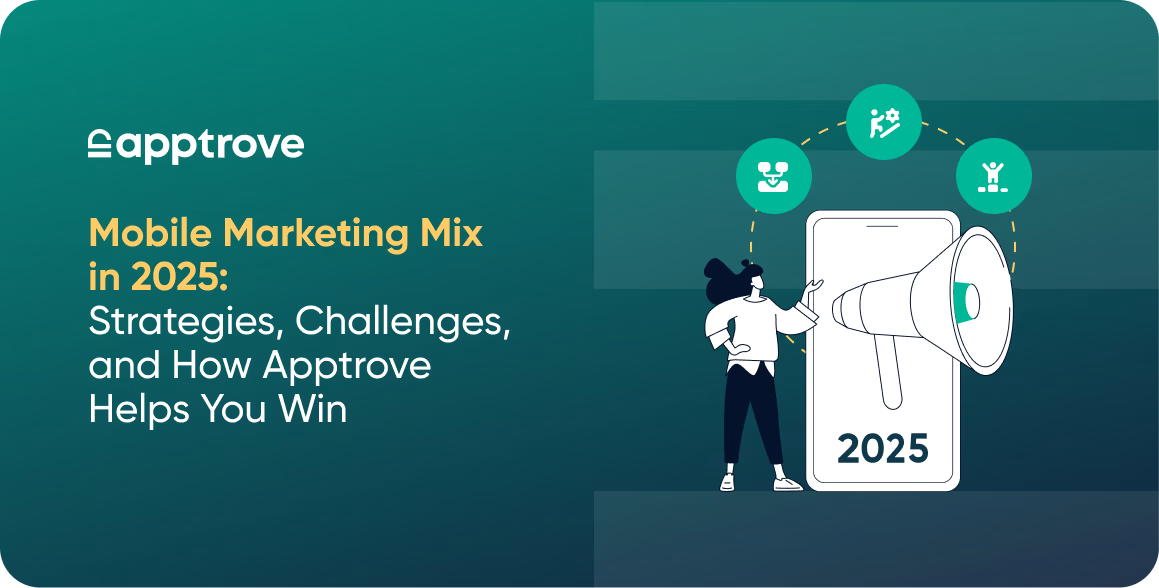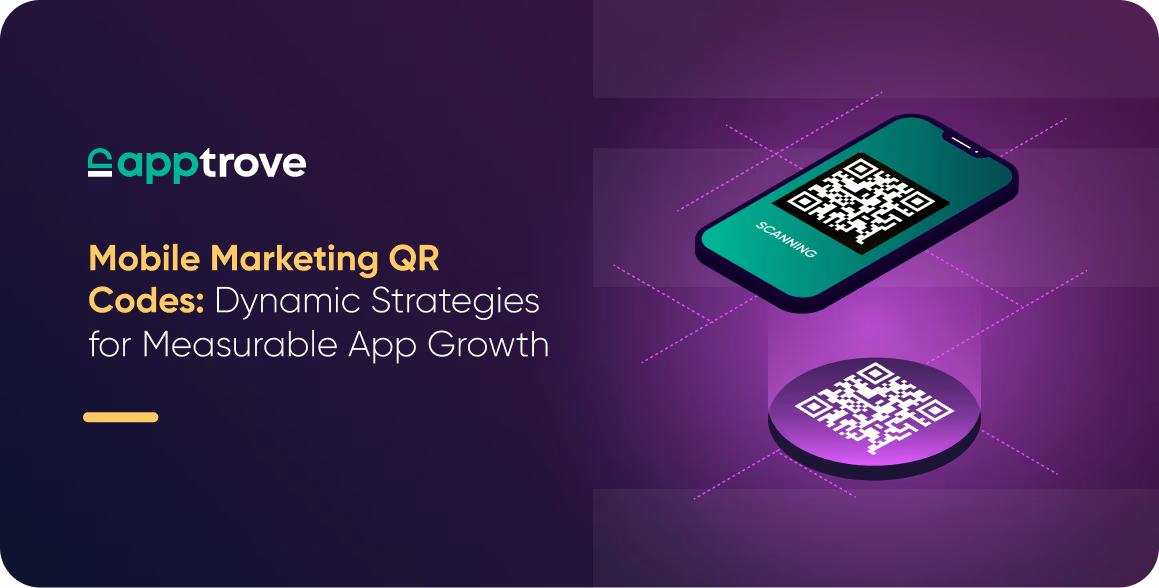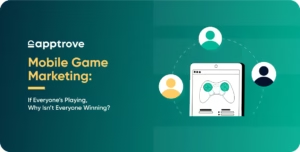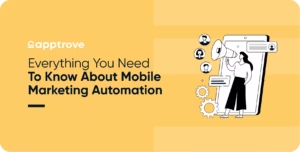Data Clean Rooms is one of the most talked-about topics in the marketing, analytics, and advertising industries.
As Google has given up support for third-party cookies from Chrome and joined Apple(Safari) and Mozilla(Firefox) in their odyssey of a cookieless world, the advertising attribution challenge has elevated. Marketers are facing inaccuracies in measuring their return on advertising spend.
This is where Data clean rooms come to the rescue, as they are the key to measuring advertising effectiveness.
In this blog, we’ll go over what data clean rooms are, the types of data clean rooms like walled gardens, MMPs etc, why you need them, and how they will affect your ability to measure campaigns.

What is a Data Clean Room?
Data Clean room is an encrypted, secure location where huge tech companies (such as Google or Facebook) store aggregated advertising data. They are used to understand advertising data better by major brands and businesses.
In a Data Clean Room, publishers and advertisers can securely store and share combined datasets for marketers to analyze and leverage their advertising efforts.
As the user data enters the Data clean room, aggregated data and insights are delivered in a cohort.
Data clean rooms have strict privacy controls where customer-level data is not used, allowing it to be a safe space for first-party user data while upholding privacy compliance.
Personally-Identifying Information (PII) is Attribution Restricted user data, that is unexposed to any collaborators in a data clean room. Hence, they cannot single out users with unique identifiers.
PII data is processed for various measurement purposes by producing anonymized data that can be crossed and combined with different sources.
In this way, brands get access to insightful data, without violating consumers’ privacy.
How do Data Clean Rooms work?
A Data clean room process can be classified into five parts:
Data Ingestion
First-party data(CRMs, site/app, attribution) is merged with a trusted second-party(brands, partners, ad networks, publishers) data partner is funneled into the data clean room.
Data Privacy
Various privacy techniques ensure that personally identifiable information linked with your customers is secure and not shared with second parties.
Data Clean Rooms offer privacy features like restricted access, differential privacy, pseudonymization, and noise injection.
Data Combination and Enrichment
Datasets of both parties are then matched in the clean room environment using a one-way hash of identifiers and made to complement each other using Data Enrichment tools.
Data Analytics
Data is analyzed for Overlaps, Intersections, Attribution, and measurement.
Although only aggregated data can be queried, without exposing individual data.
Marketing Applications
Data Clean Room has enabled marketers to many Marketing applications using this aggregated data outputs such as:
- Insights for advertising to build a more appropriate customer base
- Reach and frequency measurement
- Cross-platform planning and attribution
- Deeper campaign analysis
Types of Data Clean Rooms
Data clean rooms can be diversified into four different types, which are suitable for most businesses according to their unique needs:
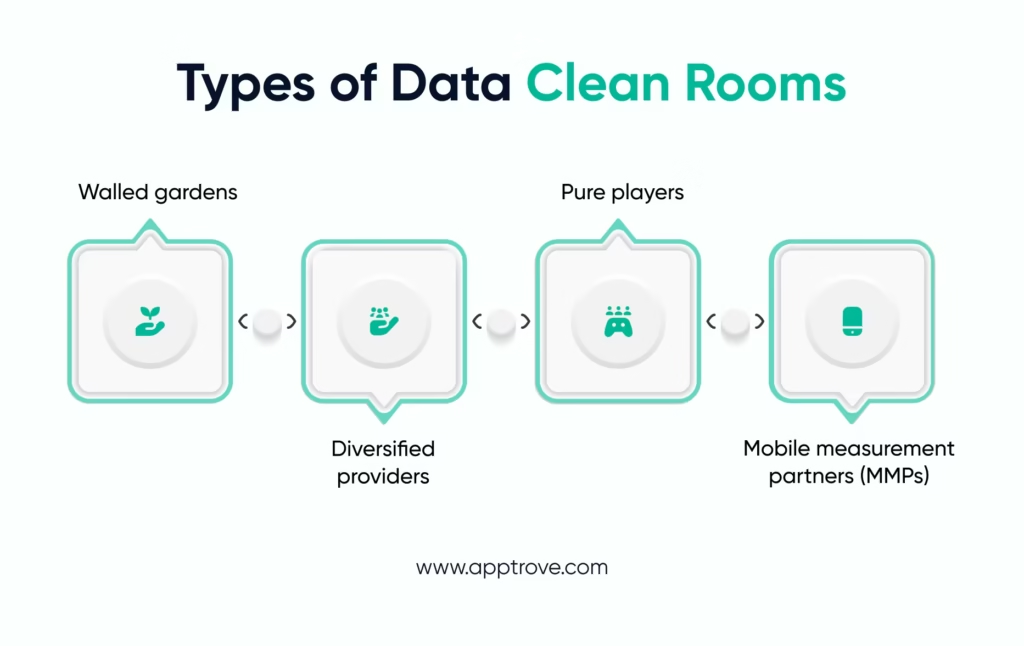
Walled gardens
Walled gardens are data clean rooms provided by big tech platforms like Facebook, Google, or Amazon, which have created a closed ecosystem with significant control over the hardware, applications, or content.
They were introduced by these tech giants to safely commercialize first-party data and measure ad spending.
The upside is the support for first-party data set enrichment with event-level data.
The downside is that they have a rigid architecture, lack the support for multi-touch attribution(no cross-platform activation data), and have strict query functionality.
Diversified providers
Diversified providers are businesses operating in the same or related industries like cloud data storage or marketing applications.
They offer organizations multiple data collaboration mechanisms to gather data signals in a privacy-compliant way.
On the upside, they offer great architectural flexibility and governance controls over data types and levels of analysis. The downside is that they have limited access to walled garden data.
Pure players
These are young and small-scale data clean room providers that develop software solutions for media companies and brands.
The advantages of choosing a pure player are that they are architecturally flexible and offer a better-unified view of the data insights.
The downsides are that they are limited in first-party data granularity, often rely on 3rd-party infrastructure for data ingestion, and can be difficult to integrate with limited downstream integration options.
Mobile measurement partners (MMPs)
An MMP is a platform that offers user-level and cross-channel data aggregated and grouped for actionable insights.
It also provides
- Conversion data in real-time.
- Analytics according to the business logic of mobile apps.
- Flexible integration options.
Check out Apptrove’s Mobile Marketing solution, which is trusted by app owners around the world, to grow their mobile marketing business.
Why do marketers need Data Clean Rooms?
In a study by Gartner, around 80% of marketers with media budgets over $1B will adopt Data clean rooms by 2023.
There can be multiple reasons for marketers to start using Data clean rooms. Here are three reasons for you to understand why you need a Data clean room?
Privacy: The alarming rise of questions over data privacy has made many marketers rethink their advertising approach.
Data Clean Rooms offer a framework that ensures that involved parties can’t access each other’s data while ensuring that PII or aggregated user-level data is not shared between different companies without consent.
Handing valuable First-party data outside a data cleanroom can be a risky affair. Hence, most marketers choose Data Clean Rooms due to a lack of commercial trust between parties.
Measuring Tool: Data clean rooms can be utilized as a tool to measure your campaign performance.
Ease of Use and implementation: Data Clean Rooms offer an increase in efficiency for synthesizing data, and allow data correlation across separate platforms, without the requirement of data scientists.
Data Clean Rooms Drawbacks and Challenges
Most data clean rooms cannot be combined with other data clean rooms and they only function for a single platform. It limits companies from analyzing advertising data across multiple platforms.
Additionally, data clean rooms set a lower limit on the number of users needed before sharing the aggregated results with the businesses. This limits businesses from getting insights for one or a small group of users.
For eg: Google’s Ads Data Hub has set a minimum limit of 50 users in order to share the aggregated results.
Alternatives to Data Clean Rooms
Data clean rooms are just one way of overcoming the challenges we face with the loss of third-party cookies, but there are other solutions.
Two other notable alternatives being discussed right now are:
Browser-based tracking
Browser-based tracking anonymizes user-level data and clusters audiences based on shared attributes.
They are an in-built or native feature of your browsers such as Google Chrome’s Federated Learning of Cohorts (FLoC) which is as effective as third-party cookies for ad targeting and measurement.
Universal IDs
Universal user IDs are an alternative to both Data Clean Rooms and Browser-based tracking.
These are used across all major ad platforms and are anonymized, so advertisers wouldn’t see a user’s personal data.
Theoretically, it would be easier for advertisers to perform cross-network attribution as the universal ID tag replicates the functionality of third-party cookies.
Conclusion
The growing interest in regulated privacy data collaborations of first-party data has resulted in an increasing number of data clean room providers.
As more companies collaborate using Data clean rooms, it has become easier for marketers to monitor, attribute, and optimize their campaigns.
Data Clean Rooms are undoubtedly a highly credible platform, which provides access and usage of data, agreed by all data clean room parties, and data governance, enforced by a trusted Data clean room provider.
Many creative and young brands are seizing such an opportunity to plan, explore and test new solutions to evolve their advertising efforts.
FAQs
1. What is a Data Clean Room in digital marketing?
A Data Clean Room, as the name suggests, is a secure, privacy-compliant space in which advertisers and publishers can merge, view, and analyze aggregated data and insights without disclosing personally identifiable information (or PII, the type of data specifically protected in a clean room). In practice, data clean rooms help brands and organizations in digital marketing measure the performance of campaigns, understand audiences who overlap with its owned audiences, and to maintain compliance and respect around consumer privacy in a cookieless world.
2. Why are Data Clean Rooms important after the phase-out of third-party cookies?
With web browsing companies, namely Google Chrome, Safari, and Firefox, excluding third-party cookies as part of web browsing their services, marketers lose their ability to measure attribution and ROI accurately. Data Clean Rooms address this concern by allowing privacy-safe data collaborations, using first-party data, and enabling advertisers to measure effectiveness while maintaining user privacy.
3. What are the different types of Data Clean Rooms?
Data Clean Rooms are typically separated into four categories:
1. Walled Gardens (e.g., Google, Meta, Amazon)
2. Diversified Providers (cloud and martech companies)
3. Pure Players (independent exclusively providers)
4. Mobile Measurement Partners (MMPs)
Each type offers distinct levels of flexibility, integration, and data accessibility according to brand needs.
4. How do Data Clean Rooms work in measuring ad campaigns?
Data Clean Rooms accept proprietary and partner data, anonymize identifiers, and merge datasets through hashing and differential privacy techniques. Advertisers can then query the data to analyze reach, frequency, attribution, and audience insights about the campaign – all limited to aggregated data which will not expose any one user data.
5. What are the alternatives to Data Clean Rooms for advertisers?
Alongside Data Clean Rooms, advertisers can consider:
1. Browser-based tracking (e.g., Google’s Privacy Sandbox) that uses aggregated audiences in an anonymized manner.
2. Universal IDs that replicate cookie-like functionality across platforms and also provide anonymity. These alternatives will also help marketers strike a balance between privacy compliance and accurate measurement of campaigns.


